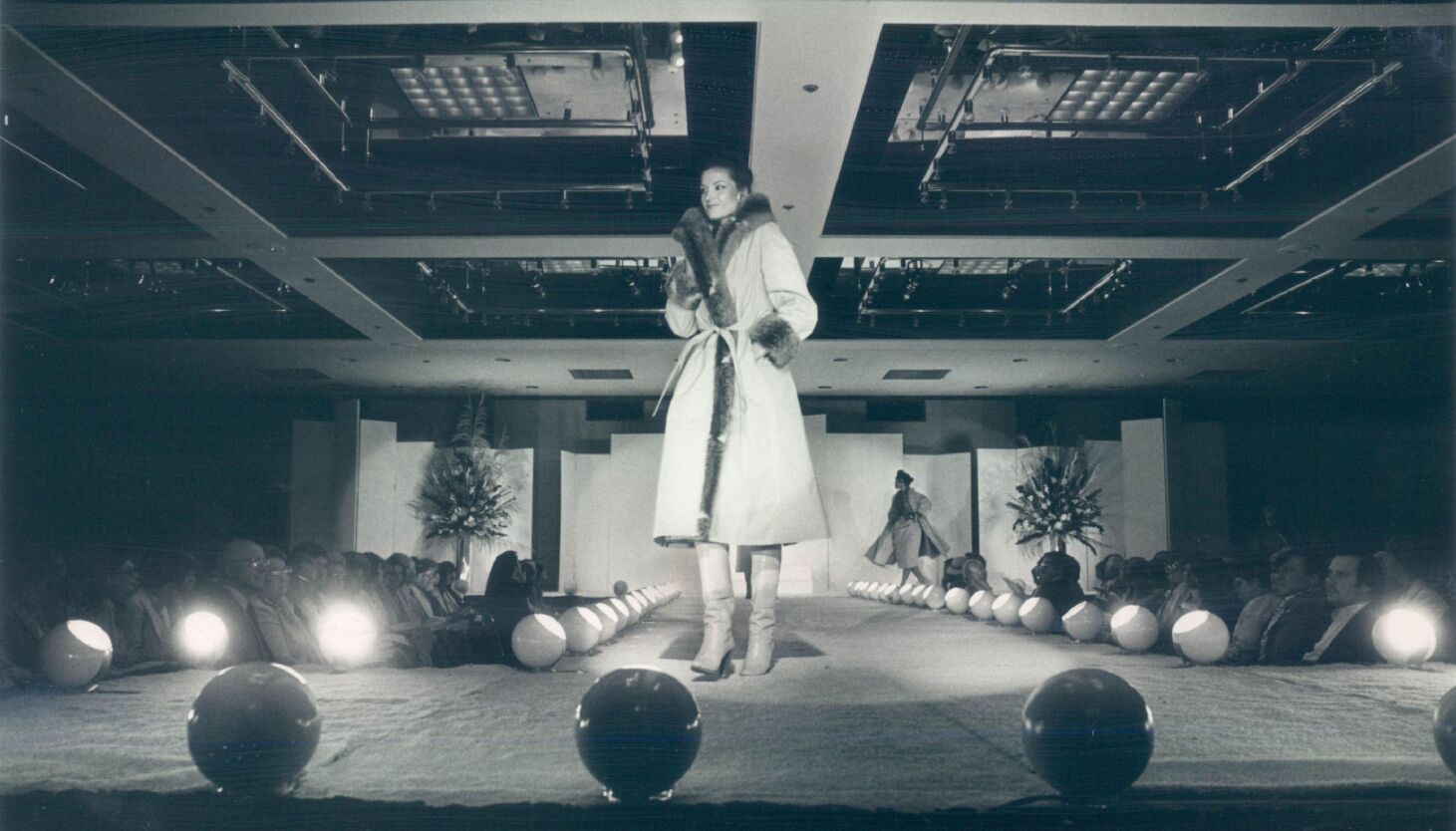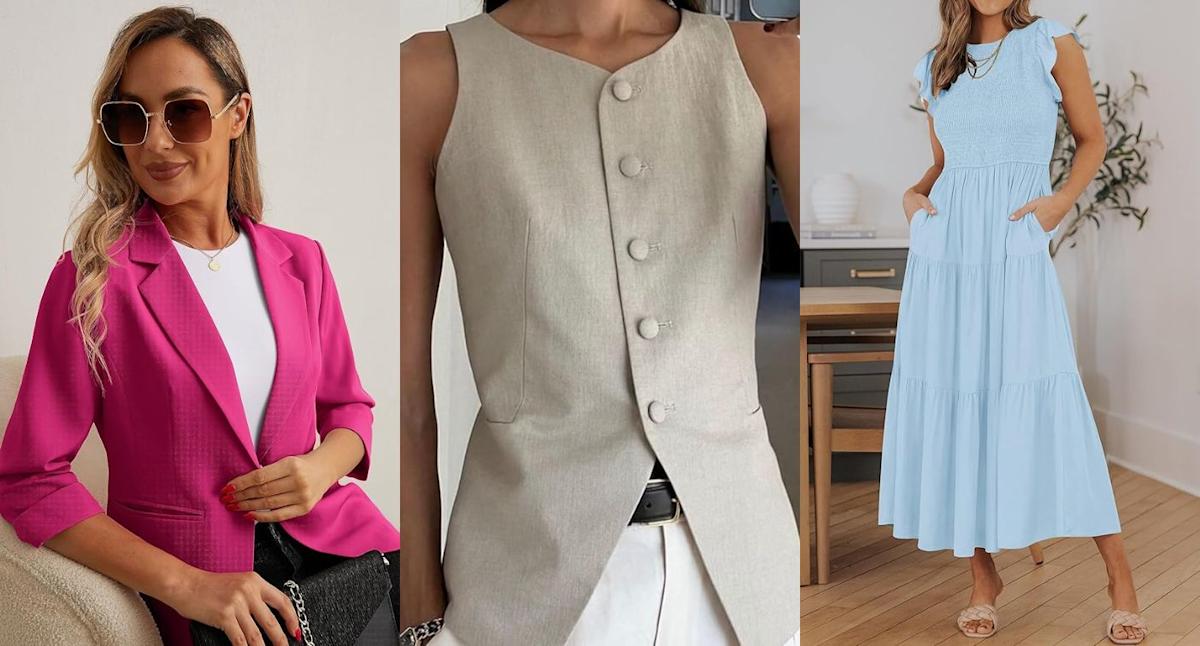WBEZ’s Curious City answers questions from listeners about Chicago and the region. We include the public in our storytelling, making journalism more transparent and interconnected.
When teacher Emily Porter showed up at Mount Sinai Resale Shop in Lakeview, she was looking to shake up her classroom wardrobe of simple blouses and slacks. She happened upon a woven sweater that “fit perfectly”; the label read “Maria Rodriguez Chicago.” This piqued Porter’s interest, as she hadn’t heard of many designers from Chicago.
“You know that Chanel is from Paris and you know that Prada is from Italy,” Porter said. “But Maria Rodriguez, like, she had her moment, and she’s from Chicago.”
Given the Magnificent Mile, Ebony Fashion Fair and the giant that was Marshall Field’s, it’s no secret that the City of Big Shoulders has always been a global fashion hub. What is less known is that the 1970s and ’80s were a golden age for fashion designers who were based in Chicago. This period could be a roadmap for the efforts to revive the industry for designers in the city today.
“Chicago’s grand dame of fashion”
During the 1970s and ‘80s, there were four fashion capitals in the US: New York, Los Angeles, Houston and Chicago. One of the people driving the industry in Chicago was Dorothy Fuller, a pioneer who tirelessly championed emerging designers to the world of fashion.
“She was Chicago’s grand dame of fashion,” said Jessica Pushor, who manages the thousands of clothing and fashion pieces in the Chicago History Museum’s archive. “Any job in fashion, that woman pretty much had it here in Chicago.”
Dorothy Fuller and her husband moved to Chicago after studying costume art at University of California, Los Angeles. She arrived to a thriving fashion industry and held various jobs at Marshall Fields. In the 1940s, she even helped to introduce Christian Dior’s “New Look” to America.
By the 1960s, Fuller was producing fashion shows across the country through her company based in Chicago.
“They were true productions, with hundreds of pieces and all these different models,” Pushor said. Fuller was so well-known that at one point, she briefly had a program on Channel 7, “The Fashion Show.”
“Imagine, just in Chicago, you would go and watch a TV show just about what’s happening in fashion in Chicago,” Pushor said. “That’s just so incredible.”
Around this time, the Magnificent Mile was at its peak. “A lot of international designers [were] setting up shop here for the first time ever,” said Pushor. “Versace set up his largest store at the time here in the 1980s.”

Regular fashion shows (top left) happened during the heyday of the Apparel Center in the 1970s and ‘80s, with buyers from all over the country and world attending. Apparel Center leasing director Harry Finkel (right bottom) stands at the future site of the Mart Plaza Hotel with Emile M. Tubiana of Dusel dorf, Germany. Tubiana brought the European Fashion Fair to the wholesaling center in 1977. Models from the International Fur Fashion Fair (top right) wear Russian coats valued at $25,000 in 1976. Members of the Kennedy family (bottom left) host Chicago civic leaders and fashion industry executives at the Merchandise Mart in 1977.
Chicago Sun-Times archive
Fuller was no stranger to the international fashion market. She traveled to Europe, befriended European designers and invited them to do fashion shows in Chicago.
“Because you can’t go to France to go see Patrick Kelly’s show,” Pushor said, “but you could come to Chicago and see him do the same show here.”
Helping Chicago designers thrive
In 1986 Fuller became the executive vice president of the Merchandise Mart Properties Inc., where she truly honed her support for Chicago designers. During her tenure, Merchandise Mart was home to so many apparel shops that in 1976, a new building was constructed, devoted solely to the fashion apparel industry. Attached to the Merchandise Mart, the Apparel Center became the heart of the clothing industry in the city at the time.
Fuller’s support for local designers didn’t end in Chicago.
“She would go to the fashion shows over in Paris,” Pushor said. “And she would talk about Chicago fashion. She would wear Chicago fashion designers.”
In the early 1980s, Fuller put together the inaugural Chicago Is fashion show, showcasing local brands and designers. The events were covered by Women’s Wear Daily, a popular fashion industry trade journal. The article featured an iconic photo of the “Chicago 21,” the who’s who of designers in Chicago at that time.
In 1982, three brands from that group of 21 were featured as “The CHICago Three:” Mark Heister, Hino & Malee, and Maria Rodriguez — yes, the same Maria Rodriguez whose sweater showed up in a thrift shop all these years later.
After being featured in Dorothy Fuller’s Chicago Is, Rodriguez’s designs were in demand across the country. Her company, Maria Rodriguez Design, sold an array of styles — from sweaters and leg warmers to athletic apparel — to over 400 stores across the US. She designed the bulk of her line in the ’80s, which meant layers and shoulderpads. “It’s big and it’s billowy,” Pushor said, pulling a layered sweater outfit out of a box from CHM storage. “It’s soft. It’s luxurious.”
Many of the designers Fuller championed went on to have careers in the industry. Maria Rodriguez was in the fashion industry for 17 years, longer than many of her peers. But her brand — and this golden age of Chicago fashion designers – did come to an end.
The end of an era
In the late 1980s, Chicago still had a thriving design community, but sewing production and apparel manufacturing were declining.
Between 1978 and 1986, the city lost 10,000 jobs in these professions. Each of the respective facets — buyers, manufacturers, designers and retailers — became siloed. Then-Mayor Harold Washington ramped up support for Chicago fashion, tapping Fuller to lead a task force to connect and advance the industry. This led Fuller to found the Apparel Industry Board Inc. in 1987. Even more comprehensive than the Apparel Center, AIBI became the central hub of information and connection for the entire industry.
But AIBI could only do so much.
Two recessions around the turn of the century transformed the life to which designers in Chicago had become accustomed. The first was in 1990, when department stores were being sold off to different companies. Marshall Field’s, for instance, was sold to the Dayton-Hudson Corporation (later the Target Corporation), which was based in Minnesota.
“[Target] decided that they were going to relocate all of the buyers to their home location, and they would be leaving the Apparel Center,” Pushor said. “So, about 1,700 jobs that were here in Chicago were going to be eliminated.”
Without these representatives for large retailers centered in Chicago, designers struggled to get their wares on clothing racks.
The 2008 recession further harmed a struggling industry, said Ambar Campos, the current executive director of AIBI.
Today’s Chicago fashion designers
Today, many designers in Chicago are working part-time, maintaining their brands as a side gig while another job or loved one supplements their income. Social media has changed the industry significantly, making it easier to sell directly to consumers, in addition to working with retailers and boutiques. Marketing is more accessible, which means designers can promote their work online and develop branding partnerships with influencers.
“[Designers] are a lot closer to the consumer now,” Campos said. “The things that sell the best are those that are authentic, and so, communicating with your customers directly through any means is great. And everybody jokes about when you buy something on Etsy, you get a handwritten note.”
Designers also rely on custom sales. “They’re working with specific clients on doing their entire wardrobe through the year,” Campos said. “Or doing three or five special pieces per year.”
Many Chicago designers have relocated to the only two main hubs for fashion left in the U.S.: New York, with its robust garment district, and Los Angeles’ center for mass production. But Campos says they’re not necessarily the best places for all designers — and not just because of the high cost of living.
“You then become a very small fish in a very big pond,” she said. “It’s very easy to just sort of disappear or flounder.”
As the direct-to-consumer market continues to define the industry, Campos said some designers follow their customers. She met a Western-wear designer who wasn’t from Austin, Texas, but she lived there because that’s where her customers were.
“They’re very strategic, and there’s no fault in that,” she said. “But leaving Chicago simply because you think it’s not a fashion place is not the best move. The resources exist; they’re just a little bit harder to find.”
Even this is changing: A number of institutions continue to seed the industry, such as the fashion education programs at Columbia College and the School of the Art Institute Chicago, Chicago Fashion Coalition, Chicago Fashion Incubator and the Apparel Industry Board.
And in 2024, Chicago Fashion Week relaunched to put the city’s fashion talent back on the global radar. The next Fashion Week is coming up in October.
Campos says all of these efforts are a part of a larger culture in Chicago of building and maintaining community.
“The industry is very large, but the community is very small,” she said. “If you do cultivate those relationships and support the community, it supports you back.”
Erin Allen is Curious City’s host.








